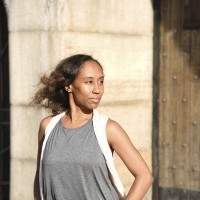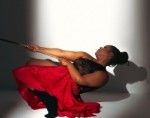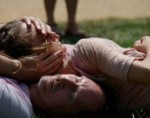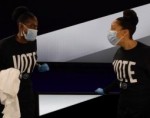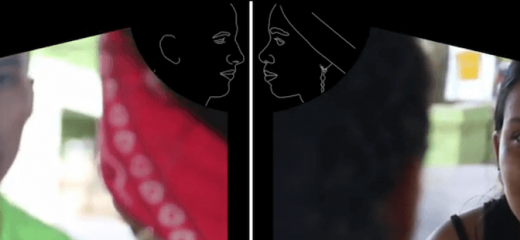
Triggering Empathy Through The Body
by Lauren Putty White
“Painful memories of living in a country torn by civil war for more than sixty years, memories imprint in people’s minds and bodies that emerge from violent embodied-experiences,” is how Diana Teresa Gutiérrez, founder of the Colombia-based organization, Embodying Reconciliation - Cuerpos para la Reconciliación (ER-CR), describes the community that she serves. Colombia, with its history of perpetual abandonment and dearth of institutions, public and armed forces, continues to deal with poverty, social exclusion and violence. EC-CR focuses on reconciling trauma through the bodies of its participants; it uses embodied practice to promote healing. Gutiérrez explores “triggered empathy” through the body. She uses movement, sound and visual components as artistic outlets to pursue an inner emancipation from trauma.
As we bring the locus of my investigation into focus, the potential of decolonality, it seems plausible that working through bodily practices would ultimately lead to a decolonizing of the self. The work of EC-CR relies on social transformation, bringing groups of people together to work through past traumas and seeking paths towards healing. In working with communities that have faced violence and displacement in their countries, EC-CR hones in on “the aura of the body memory to create,” pointing out how powerful and intuitive the body can be. This work is like an archive of one's personal history. Gutiérrez contends that
“One of the fundamental requirements of ‘Intangible Cultural Heritage’ is that it is a lived practice in community, rather than a snapshot or ‘museumified’ artifact. When many people are struggling to integrate the past and present, safeguarding traditions that are related to the past is not always straightforward. This is why our work focuses so much on empathy, the body, emotional work, collective action and heritage.”
It is the bodily practices of ER-CR that foster self-connection, which impacts the history of oneself and their surrounding communities.
After interviewing Gutierréz about her organization's methodologies, I participated in her Decolonizing Dance Writing workshop on October 23rd. Though on zoom, the beginning warm-up, Getting in the Body, immediately centered me. Led by Gutiérrez, we repeated a series of aerobic movements consisting of marching, boxing, and planking, staying in rhythm with the music. As we danced to songs like Una Cancion en el Magdalena, Ghetto Kumbé, and Lacrimosa, I felt refreshed by my own tiredness and sweat! We transitioned into Expressive Movement and Mapping Our Emotions, a time during which we sought to explore and connect with our bodies. Through a guided improvisation, we literally pondered questions about our kidneys and hearts while we moved. Some of our other movement prompts included questions like “What is the shape of my body today? What are my capabilities? What impulse do my desires have? and “How difficult is it for me to eliminate (get rid of things that aren’t valuable to your well-being) or say no?” Each of these questions were linked to different parts of the body like the hands and feet or the spine. Addressing these questions while carving and shaping my body through space was a physical problem-solving which challenged how I thought of improvisation as being a singular path to discovery. Whenever I came to a pause during this exploration, my movement phrasing always found a way to complete what I started. It felt resolved, as if dancing unlocked answers to questions I would otherwise have difficulty addressing verbally. This was not only undeniably satisfying, but it also revealed a decolonizing of my own thought. Throughout this experience, I asked myself if I had been separating myself from old approaches to movement that was more analytical rather than physiological or emotional. How could this new approach be a healing path when executed in a thoughtful way? In my previous dance improvisation class experiences, the “colonized” practice was always guided by prompts from the instructor and outside sources of inspiration. In this instance, we had to strictly draw from within. We had to pull on our uniquely personal narratives and I found that to be refreshing.
I was relieved to have a moment to exist in movement while exploring different parts of my body. Having a focus during this improvisation helped me to “let go” of my typical chaotic morning with two small children, an experience that usually permeates a large part of how I move throughout my day. Instead, I could just be present in the moment. This exercise would be useful to anyone dealing with a form of chaos because it truly centralizes one’s self-view. Since the theme of the workshop was about being in confinement, I reflected on how confinement usually causes me to be even more introspective than usual and so, I allowed my movement exploration serve as my introspection. This movement/emotional exploration lasted for 30 minutes as this constant moving invited new discoveries with which to engage. Immediately following this exercise was a “cool down.” This section, appropriately named Diary of My Confinement Journey, was an invitation for us to journal about our experiences. Gutierrez instructed us to write or draw a memory of our bodies that referred to confinement. For ten minutes we wrote from our stream of consciousness. We chose three salient words to best describe our experience. I chose “inquisitive,” “pensive,” and “focused.” Journaling in this format felt like shedding layers of old thoughts and ideas. Also, being forced to write immediately after dancing made me think about my relationship to movement and thought patterns in a way that was more explorative in my physical choices.
The workshop concluded with Living Paintings in Confinement, where we were placed in breakout rooms and asked to create a living scene that embodied what it means to be in confinement. Using some of our salient words from our journal exercise, my group ended up with a presentation titled Pensive Clock. Time and space were the common thread between us, and everyone had the option of using video, photography or sounds to present their living scene. It was a moment of collective beauty, a social transformation, as my group decided to take individual screenshots of gestural poses representative of the theme. This moment was about taking collective action to create shared understandings of each other’s stories.
According to Gutiérrez, “you cannot transform anything without awareness.” By using movement to answer those emotionally provoking questions from the Mapping of Emotions exercise, it gave the movement meaning. Not only did it compel us to seek independence in thought but it also incited a collective journey to a shared desired outcome. Instead of just playing recorded music and being told to improvise based to what the music dictates, “mapping” our emotions pushed us to investigate the who, what, where and why of our state of being. It makes sense that one can begin to transform once they are informed. After actively participating in this workshop, it occurred to me how essential awareness is to an act of decolonization. I believe that Gutiérrez has found a creative niche to meet the healing needs of her Colombian community. In this sense, decolonization is a healing pathway that involves unpacking, re-evaluating, and resetting circumstances. That unpacking (decolonizing) begins with the self. EC-CR focuses on helping people create awareness of who they are and where they come from, so that they can begin to build anew on the self and community in which they reside.
By Lauren Putty White
January 8, 2022

